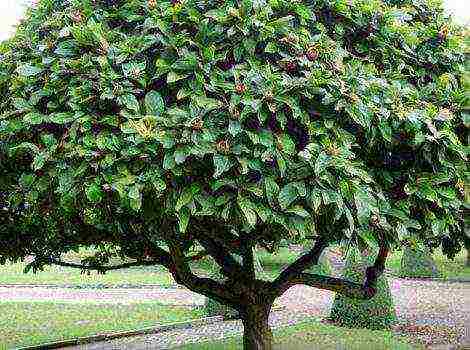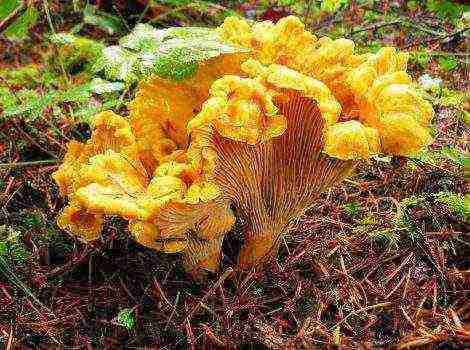Content
- 1 Basic requirements for growing
- 2 Kiwi - growing at home
- 3 Features of vegetative reproduction of kiwi
- 4 How to get a big harvest?
- 5 How and where does kiwi grow in nature
- 6 Growing at home
- 7 Why does kiwi die?
- 8 Step one - preparing the seeds
- 9 Step two - planting seeds
- 10 The third step is planting germinated seeds in the ground
- 11 Home care for kiwi
- 12 Watering and lighting
Almost all growers seeking to improve their own skills at one point decide to grow fruit-bearing crops, such as citrus fruits, coffee or vines. And many are wondering if it is possible to start growing kiwi at home. In reality, this is quite possible, however, certain requirements must be observed in the process.
How kiwi appeared: an interesting fact
Kiwi is also known as Chinese gooseberry. And in order for this culture to begin to bear fruit, you need to simultaneously grow two varieties of plants - male (required for pollination) and female. If you plan to grow by seed, then be prepared to wait for the flowering period, because that's when you can determine the gender of the vine. In most cases, kiwi blooms in the sixth year of life.
We grow kiwi at home
Basic requirements for growing
So, the growing process is not difficult, but you will have to show accuracy, care and patience.
How kiwi is grown
You can grow kiwi:
- cuttings;
- seeds;
- accessory buds of the roots.
All methods have their own nuances, advantages and disadvantages, which we will get acquainted with a little later. However, there are a number of general rules that apply to kiwi breeding.
Kiwi is a distant relative of grapes, and therefore uses a similar cultivation technology. The described culture is warm and photophilous, so it must be placed in a well-lit place (preferably without drafts). It should be remembered that the direct rays of the sun can lead to burns of foliage, therefore, the light should fall from the side. An even better option is vertically directed artificial lighting.
Kiwi from seed
In the process of development, the pots should be periodically scrolled clockwise (every two weeks, 10-15 °). This will provide the plants with a straight silhouette, and the crown will turn out to be dense and uniform.
Note! There are many varieties of kiwi, but, characteristically, almost all of them are suitable for growing at home.
Kiwi varieties
Yellow kiwi
It should also be remembered that kiwi is a dioecious crop, and therefore one male and at least two or three female plants are required for normal fruiting. If kiwi is grown from seed, then about 80 percent of the seedlings are male, so there should be as many of them as possible.
Now let's look directly at the workflow.
Kiwi - growing at home
It is better to start growing kiwi in early spring, because then the highest germination of seeds is observed. This is a very important point, so do not delay sowing.Also consider the fact that kiwi naturally grows in regions with long and warm summers, so the conditions for the plant should be as comfortable as possible.
Traditionally, the process begins with the preparation of everything needed.
If you really want to grow kiwi at home, make sure you have enough free space.
Stage one. We prepare everything you need
To grow vines, you must prepare:
- one ripe kiwi fruit;
- neutral or slightly acidic soil intended for citrus crops (you can purchase it at any specialized store);
Citrus primer
- thoroughly cleaned river sand;
- mini greenhouse (you can use PET film instead);
Mini greenhouse
- fine-fraction expanded clay - it will be used for drainage.
"Shop" soil can be replaced with a self-prepared soil mixture consisting of peat, sand and black soil (in equal proportions). By the way, when you dive seedlings into pots, this soil mixture will also work well, only there should be less peat in it.
Stage two. Preparing the seeds
Cut the fruit in half
Take a ripe fruit and cut it in half. You can eat one part, and extract about 20 grains from the other. Peel the pulp from the grains (otherwise they will rot in the ground), but do it carefully, do not damage the shell. To simplify the procedure, you can throw the seeds into water, mix them well and leave to settle for a while. Repeat the process two to three times to minimize the risk of seeds rotting.
Then spread the seeds on a napkin and dry for four hours.
Collection of kiwi seeds
Stage three. Germinating seeds
Step one. Place a piece of cotton wool in a saucer and pour boiling water over it. There should be enough water so that the cotton wool is saturated with it, but the saucer should not be poured.
Step two. Cover the saucer with a piece of plastic and place in the lightest spot in your home.
Step three. Remove the film every evening, and return it the next morning, adding a small amount of water (the cotton wool should be wet all the time).
Soak the seeds
Step four. After about a week, when the first shoots appear (in the form of thin white roots), you should plant the seeds in the soil.
Germinating seeds
Stage four. We transplant seeds into soil
As for the soil, then it should be the same as indicated in one of the previous paragraphs. Pour it into prepared containers or pots (the bottom must be previously covered with expanded clay drainage layer) and make small holes on the surface (the depth should not exceed one centimeter). Place the seeds in the holes, sprinkle lightly with soil, but do not tamp.
Cover the containers with foil or glass and place in a warm place. Alternatively, you can put them in a mini greenhouse. Thereafter, water the ground daily. It should not dry out, otherwise the sprouts will simply die. When watering, you can use a spray bottle, or you can place the pots in a pan and pour water there.
Seed-grown kiwi sprouts
Note! When the first shoots are formed, start accustoming to fresh air. To do this, remove the glass / film daily, increasing the ventilation time over time.
Stage five. Making a pick
About four weeks after planting the seeds, when there are several true leaves on the seedlings, perform a pick, that is, transplant the plants into individual pots. The soil at this stage, as noted earlier, should already contain less peat, while more sod soil can be used. At the same time, act very carefully, because the root system of vines is extremely delicate and located on the surface, which means that it is easy to damage it.
Kiwi after a dive
What is a transplant for? The fact is that this plant has rather wide leaves, which, as they develop, will shade each other.
Sprouts with large leaves
How to grow kiwi at home
Stage six. Further care
To ensure that conditions are as close to natural as possible, you must adhere to a number of rules. Let's consider these rules in more detail.
Growing kiwi from seeds
Table. Key Requirements
| Humidity | The earth, as we have already found out, should not dry out, so take care of uniform watering. It is preferable to use a spray bottle rather than a watering can - this will moisten the entire soil surface at once, and the plants will not be damaged. It is also advisable to count the number of sprinkler clicks so that each time the amount of moisture introduced is the same. |
| Pinching | Pinch the upper part of the vine from time to time - this will stimulate the formation of lateral processes, and the plant itself will turn out to be stronger. |
| Lighting | Kiwi needs a long day of light, which means, if possible, place containers on the windowsills on the south side. If this is not enough, extend the lighting time artificially with a fluorescent lamp. In winter, the lighting should be horizontal. |
| Feeding | Use organic fertilizer - compost or vermicompost. Apply it every year, digging a small trench around each plant beforehand. In this case, when watering, the top dressing will gradually flow to the root system, so that the vines will grow healthy. |
Note! In the summer, additionally apply a complex type of mineral fertilizer. Do this about once every seven to ten days.
Features of vegetative reproduction of kiwi
Seedlings of this culture are grown using the same technology as described above. The only difference is that the seed must be sown in January. Two years later, a kiwi of one or another variety is grafted onto a seedling, which by that time will grow up and get stronger.
Kiwi seedlings
Seedlings before planting in soil
Grafting can be done in the same ways that are used for other plants; in particular, these are:
- budding;
- cleavage with a green handle;
- a similar process, but with a lignified cuttings.
The vine can then be planted in open soil. If the kiwi will be grown indoors, as in our case, then you should take care of a container of sufficient depth (the roots should have a lot of room for further growth).
You can also grow seedlings from rooted cuttings. The disadvantage of this method is the low germination rate in indoor cultivation - there are either few or no plants at all. As for further care, it is the same as when growing by seeds. When the cutting / seedling enters a period of active growth, it will no longer be afraid of low temperatures and can easily adapt to any conditions.
Planted kiwi seedling
How to get a big harvest?
Liana needs to be placed correctly. It needs a lot of space, so it is better to grow it on an insulated balcony. Also organize a support for the plant to climb, or make a beautiful and original balcony frame out of it. The length of one vine, by the way, can reach seven meters.
Kiwi on the loggia
Note! Pollination should be taken care of to obtain fruit. In natural conditions, insects are engaged in this, in our case, you must do everything with your own hands.
If there are too many male vines, you can plant "eyes" from female vines on them, which will allow you to get fruits. Ideally, five or six females should fall on a male plant, and if the proportions are not correct, then it is better to vaccinate. The “eyes” take root well, thanks to which the yield will increase significantly.
Video - Kiwi inoculation
Also, periodically inspect the kiwi leaves, and for two reasons at once.
- This will allow you to detect the fungus in time and clean the leaves.
- Liana can be "infected" by various pests from neighboring plants, so in addition to inspection, try to place kiwi as far away from them as possible.
With the onset of autumn, cut off old shoots: those branches that have already borne fruit are recommended to be removed. This will free up space for new shoots, and the vine itself will not age and will bear fruit for many years.
Kiwi harvest
If the vine grows on the balcony, then in winter you will have to additionally protect it from frost. To do this, remove the shoots after scrapping and wrap them up. When spring comes, they will sprout more young shoots.
And in conclusion - one more useful advice. For some reason, cats love the branches and foliage of kiwi, so if you have such a pet, then take care of protecting the plant - you can, for example, enclose it with a net. Otherwise, the kiwi may die.
How to wean a cat from walking according to flowers? Ordinary toothpicks will help you.
Seedlings in a cage
Video - Features of growing kiwi
 Is it possible to grow a kiwi tree indoors? Experienced gardeners say yes! Moreover, even a beginner can get a house plant on the windowsill that will bear fruit. Its cultivation is quite painstaking, but many call the process fascinating for this. Description and photo instructions will help you understand the algorithm.
Is it possible to grow a kiwi tree indoors? Experienced gardeners say yes! Moreover, even a beginner can get a house plant on the windowsill that will bear fruit. Its cultivation is quite painstaking, but many call the process fascinating for this. Description and photo instructions will help you understand the algorithm.
Home growing kiwi: what you need to know before planting
In the wild, the Chinese gooseberry kiwi, like apples or pears, is a small 30-gram fruit. The habitual large fleshy fruits from 100 g and heavier were received by breeders of New Zealand. Today fruits with a refreshing delicate taste are popular all over the world. In addition, they are very useful and are used in cosmetology, as well as for the prevention of a large number of diseases.
Kiwi grows on beautiful, tree-like vines that resemble a vine. At home, the fruit tree is grown from seeds. Key points to consider before boarding:
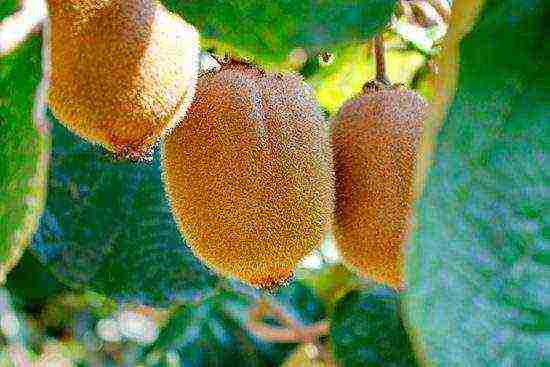
Kiwi needs plenty of sunshine
- Kiwi is a dioecious crop. To grow fruit at home, you need at least two plants. You can only determine which specimen is female and which is male only during flowering. Therefore, it is better to plant several vines at once.
- Under optimal conditions of maintenance and care, you will receive the first flowering and fruits no earlier than after 4-6 seasons.
- Any varieties are suitable for growing in a room setting.
- The plant needs about the same conditions as the grapes. For example, in the abundance of sunlight.
If your home does not have south-facing or adjacent windows, a normally developed plant may not come out.
Attention! There are special frost-resistant varieties that are suitable for growing in the open field of the middle lane. The conditions and care in this case are similar to those in the room. Only for the winter should the plant be wrapped. It may take up to 10 years to wait for fruits from such vines.
Planting kiwi: technology and features
Gardeners recommend starting all kiwi planting procedures in early spring. This time is considered optimal to obtain maximum germination. Kiwi seed is not difficult to find. Buy a fully ripe fruit that is soft and crumbly. Without peeling, cut it in half.
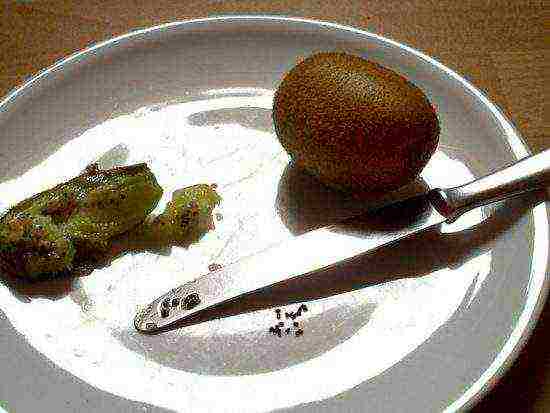
Take seeds from ripe juicy fruit
Then proceed like this:
- remove about 20 seeds, carefully remove the pulp from them;
- wrap the material in cheesecloth and rinse several times with tap water;
- Spread the seeds on a saucer and leave to dry for a couple of hours under normal room conditions.
Attention! At the stage of harvesting seeds, you need to completely get rid of the pulp. Otherwise, the material will start to rot.
The next step is to germinate the seeds to speed up germination:
- Place cotton wool, moderately soaked in hot water, on a saucer. Place the seed on it.
- Place the plate on a well-lit windowsill and cover with plastic wrap. The mini-greenhouse should be opened at night. But make sure that there are no drafts at this time. In the morning, wet the cotton wool again with hot water and stretch the film.
Under these conditions, the seeds should form seedlings in 7-10 days. Maintain the regimen until you see delicate white roots. Now the germinated seeds should be transplanted into the soil:

Kiwi sprout
- Mix equal parts humus, peat, turf and sand.
- Fill small pots with soil. In each, right on the surface, put a few seeds. Sprinkle them on top with a thin layer of soil. You can't ram the ground.
- Spray the planting daily, keeping the topsoil moist. Use only a spray bottle, simple watering cannot be carried out.
Advice. Moistening the earthy coma during this and subsequent stages of growing is extremely important for the plants. Therefore, other methods are also suitable for these purposes. For example, installing a mini greenhouse with half plastic bottles above each pot. However, an excessive amount of water for the root system of the plant will be detrimental.
Growing kiwi: caring for young plants
For fruit tree care to be effective, bring the growing conditions as close as possible to its native, natural ones. Kiwi grows in a climate of long, warm and humid summers. In addition to low humidity or an excess of water, the plant does not like:
- cool climate, temperatures below +20 ° C;
- a sharp drop in temperature even in warm weather;
- wind;
- lack of sunlight.
Advice. If these features are taken into account, you can take the plant outside in the summer, and at other times of the year - on a warmed loggia or balcony.
Other nuances of kiwi care:
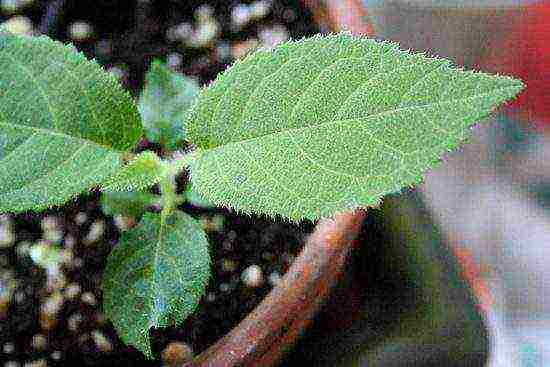
Fertilize your kiwi fruit regularly
- The key to the health and beauty of the tree is feeding with organic fertilizers: vermicompost or compost. The mixture is applied in the spring, no more than 2-3 times. You can add the entire composition of fertilizers and one-time, dry, in a trench dug around the stem. In the process of watering, the substances will gradually flow to the roots.
- In summer, gardeners recommend fertilizing kiwi with mineral complexes. Frequency - 3-4 times a month.
- Pinching the top from time to time will help to strengthen and make the vine more branched.
- A month after rooting in the ground, the plant will need a new transplant.
- Each plant needs a separate pot. It is important that wide leaves do not block the access of light to each other.
- Room conditions will not limit the growth of vines. An adult plant can grow up to 7 m in length. For vines, you need a support (for example, trellises), along which the kiwi will climb to the ceiling.
How to get a kiwi harvest at home
The optimal ratio of male and female plants for a good harvest is 1 to 5-6. It is very likely that by blooming you will find that this is not the case. Often there will be more male specimens than necessary. In this case, grafting of female twigs-eyes on their stems is effective.
The gardener will have to pollinate the plants on his own. Transfer pollen from male flowers to female flowers with clean and disinfected tweezers.
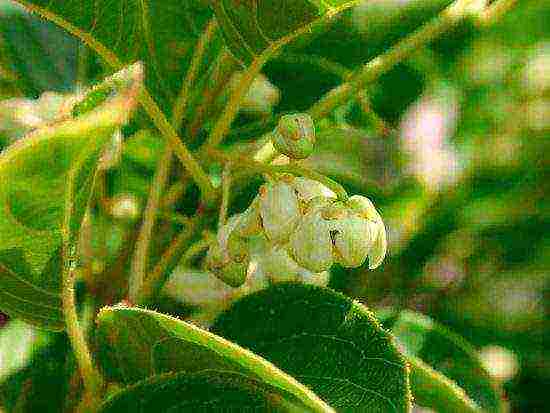
Flowering kiwi
To prevent the plant from degenerating, remove old branches in the fall, especially if the shoot has already borne fruit. This will make room for young vines and keep fruiting at the same level.
Attention! Kiwi is not very resistant to pests and diseases of indoor plants. Keep it away from other plants. In cases of infection, use standard methods of control and prevention of a specific ailment.
Kiwi is surprisingly easy to grow in your home. Attentive owners will be able to enjoy the exotic taste from their own windowsill.
Growing kiwi at home: video
This rough, pubescent berry is just a storehouse of vitamin C. It is hard to believe that it has existed in this form for less than 100 years. Thanks to New Zealand breeders, it has become larger and much tastier.To understand whether it is possible to grow a healthy berry at home, imagine how kiwi grows in our homeland.
How and where does kiwi grow in nature
Homeland of Yang Tao, which means strawberry peach in Chinese, China. The culture belongs to the genus Actinidia, the species Actinidia Chinese. It was brought to New Zealand at the beginning of the 20th century. A Chinese berry weighed no more than 30 g. Thanks to selection, it became larger, its taste was enriched without detriment to the beneficial properties that allow the fruit to be used for the treatment and prevention of many diseases.
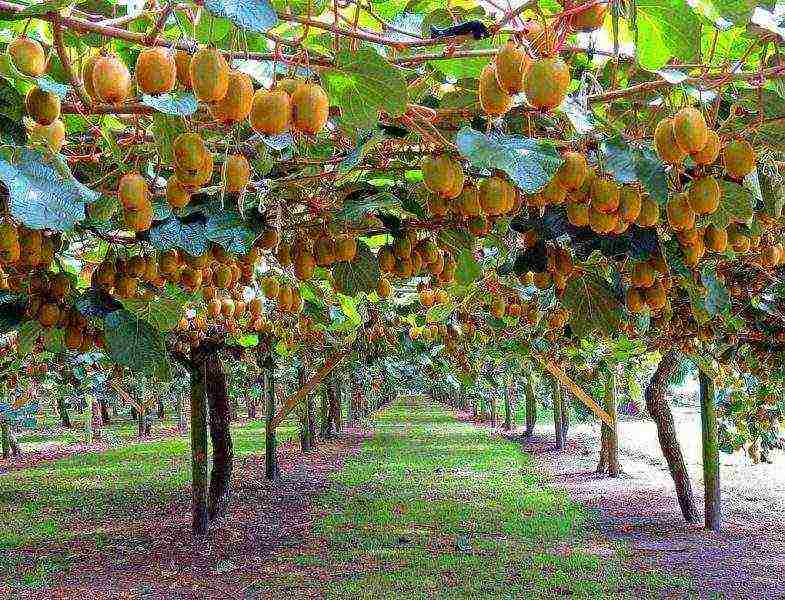
Like its progenitor, the kiwi is a vine. But in the wild, it does not occur. This is an artificially improved plant. Even a new name has been invented for it.
Where does kiwi grow? Cultural plantations of exotic fruit can be found wherever the climate allows it to grow: in Italy, South Korea, Chile, Greece. But the recognized leaders in the production of this healthy berry are New Zealand and China. So the kiwi triumphantly returned to his homeland. Despite the considerable difficulties associated with the cultivation of this exotic fruit, not so long ago the first plantations appeared in Abkhazia, in the south of Dagestan, on the Black Sea coast of the Krasnodar Territory. In a word, now in order to find out how kiwi grows, you do not need to go abroad. You can see this exotic in our country.
Kiwi can withstand temperatures as low as -15 degrees, so it hibernates well under cover, even in regions with cool winters.
A biologist from Uzhgorod G.V. Straton, through long-term selection, created a new Kiwi variety - Valentine, which can withstand frosts up to -28 degrees without freezing! This plant will be able to winter even in the middle lane.
Liana needs support; in a wild forest, trees play its role. On plantations, supports are created artificially, by tying plants to specially stretched nets and installed posts.
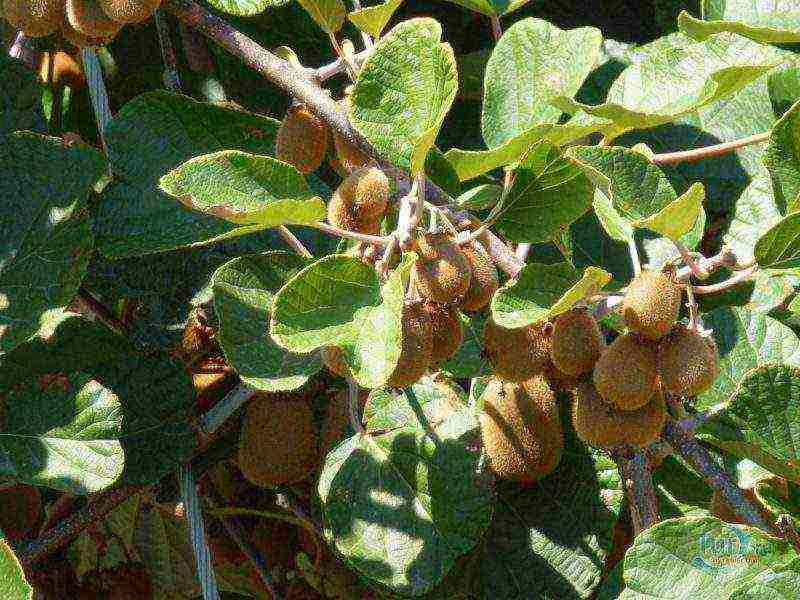
What does kiwi grow on? Like his ancestors, he loves fertile, loose soil with a high humus content, moist, but without stagnant water. Actinidia in the forest most often grows in partial shade. The cultured kiwi prefers the sun. And he also needs regular watering, feeding, mulching, pruning and shaping. There is a lot of trouble in growing this berry. But this does not stop real gardeners. Many people try to grow the valuable fruit at home.
Growing at home
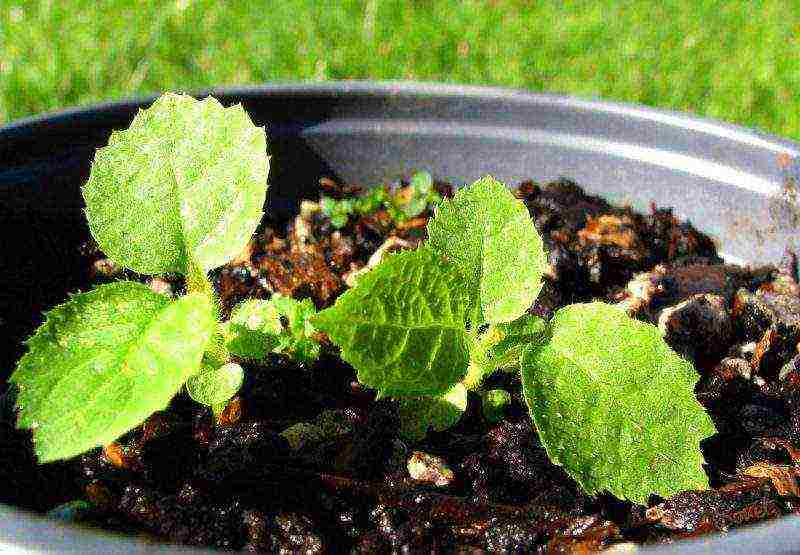
Growing kiwi from seeds is an exciting activity that requires patience and adherence to all the rules of agricultural technology. The first fruits will have to wait a long time - kiwi blooms only 3-4 years from sowing, sometimes flowering occurs only after 6 years of cultivation. But even flowering is not a guarantee that the fruits will set. This plant requires a pollinator. It is necessary that a kiwi-man and a kiwi-woman settle nearby. To maximize the likelihood of such a neighborhood, several copies of this exotic fruit will have to be planted in pots, since it is possible to find out which plant has grown - male or female, only with the beginning of flowering. On female specimens, the flower pistil is much larger. There are monoecious plants that have both male and female flowers at the same time. They don't need a pollinator.
With seed propagation of kiwi, at least 70% of the plants will be male.
Seed preparation and germination
Seeds are easy to obtain. All you need to do is buy kiwi at the store. The fruit must be fully ripe. The seeds are most germinating in early spring. It is at this time that they begin to germinate.
The algorithm for preparing seeds for sowing is as follows.
- Seeds are removed from half of the fruit and thoroughly washed from the pulp.
- The seeds are dried.
- Placed on a cotton pad moistened with hot water, which is placed on a saucer.
- Put on a plastic bag and put it in a warm place. The bag must be removed regularly to ventilate the seeds. The cotton pad should always be moist, but not waterlogged.
- As soon as small roots have appeared, it is time to plant the seeds.
Soil transplant
For initial growing, plastic containers with a small transparent lid are most suitable. This is a ready-made mini-plate for plants. At the bottom of each container, drainage is made and it is filled with a planting mixture of peat, sand, humus and turf in equal parts. Seeds are laid out on the surface of a moistened planting mixture and sprinkled with a thin layer of soil. Its thickness should not be more than 3 mm. Germinated seeds germinate in 2 weeks. It is necessary to spray the surface of the soil with water, as young seedlings are very sensitive to lack of moisture. Delicate seedlings are shaded from direct sunlight. As soon as the plants form 2 pairs of true leaves, they dive into a larger container.
How to make a pick?
In order for the plants to grow and develop well in the future, the soil for them is prepared in the same way as for seedlings, but the amount of peat is reduced by increasing the proportion of sod land and humus. The root system of kiwi grows more in width than in depth, so the containers for planting are not too deep, but wide.

The sequence of actions when diving.
- Drainage is made at the bottom of the planting container.
- Cover it with soil at 1/3 of the height of the pot.
- Carefully remove the plant from the container in which it grew before the pick. The earthen lump cannot be disturbed, therefore, 2 hours before the pick, the plants are watered.
- Place the plant in a new pot, dusting the roots with soil.
- The first few days after a dive, small kiwis especially need protection from direct sunlight.
Kiwi propagation
The seed reproduction method is described in detail above. It is inconvenient in that you have to not only grow a lot of plants, but also wait a long time for fruiting. It is much easier to propagate kiwi fruit vegetatively. For this, both lignified cuttings of the first year of life, which are harvested in winter, and green ones, which are cut in summer, are suitable. Rooted, they will completely repeat the characteristics of the plant from which they were cut.
The cut branch should not be thinner than 5 mm and have 3 buds. You need to cut them with a well-sharpened knife so that the slices do not wrinkle. The bottom cut should be just below the kidney and slope 45 degrees. The upper cut is made straight, retreating from the kidney by about 1 cm. In cuttings of summer harvesting, all leaves are cut off, except for the top one. It is shortened by a third. The prepared cuttings are placed in a lower cut into a container filled with water at room temperature to a height of 4 cm. After a day, they are transferred to a solution of a root formation stimulator, in which they are kept for 24 hours. In both cases, a plastic bag is put on a container with cuttings. After that, the cuttings are ready for planting in a cuttings with peat soil. The mini-plaque should have a double cover - a film and a nonwoven backing. When using artificial fog, the rooting rate of cuttings is up to 95%. Rooted cuttings are planted in separate containers and grown in a greenhouse. In warm climates, the plants are ready for planting in the ground after a year, in other cases they are planted after 2 years.
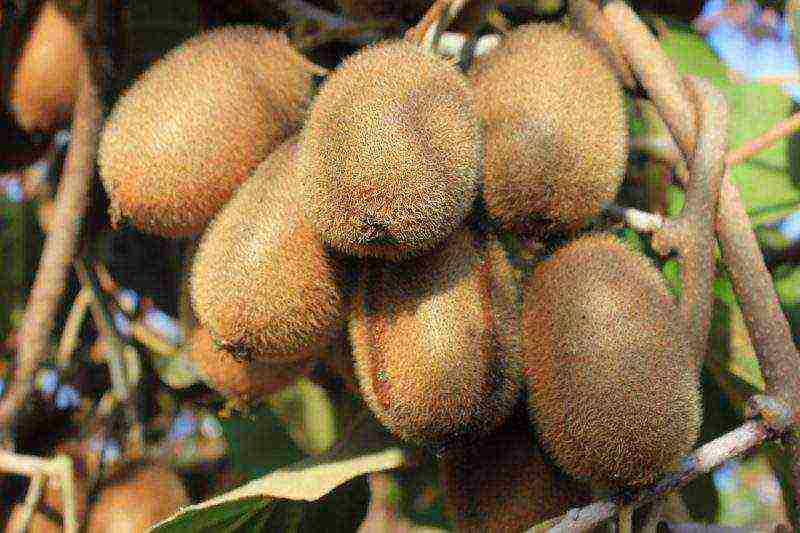
Kiwi can be propagated by pieces of roots from 1 to 1.5 cm thick and up to 30 cm long. They are planted in a substrate with a temperature of about 24 degrees. It must be constant, so bottom heating is needed. As soon as the shoots that have grown from dormant buds reach a height of 15 cm, they are transplanted into separate containers, shortening the parent root. In the future, they are grown in the same way as rooted cuttings.
To obtain a large number of seedlings on plantations, the grafting method is used: in splitting, simple and improved copulation, summer budding with a shield in a T-shaped incision. Budding can be done in spring and summer, all other types of vaccinations are carried out before bud break.
Care features
For the successful cultivation of kiwi, 3 components are enough: a lot of light, timely watering and annual feeding with vermicompost or humus.
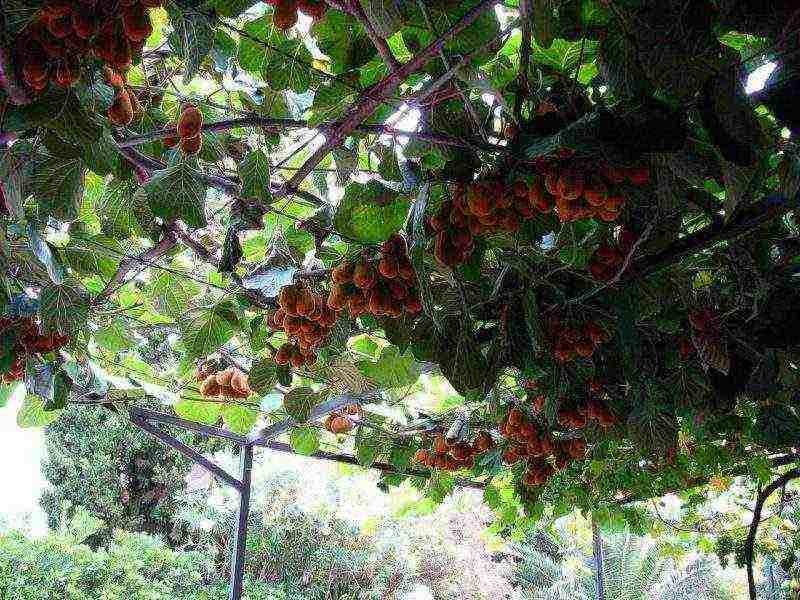
This plant can only be grown on a southern windowsill, but the light must be diffused. In winter, additional lighting with phytolamps may be required. Do not forget that it is a liana and will thank you for good care with rapid growth - an adult plant can grow up to 7 m.In the process of growth, it needs support. Any artificial limitation in growth will necessarily affect flowering and fruiting. You can prune kiwi only in the dormant stage in winter, which requires a temperature of about 10 degrees Celsius, and after the leaves have completely bloomed in summer. In the phase of the beginning of sap flow, the plant is very vulnerable and can simply drain out of juice. Pinching the tops of the shoots will allow the plant to grow wide. In order for it to develop evenly, the kiwi pot needs to be rotated 15 degrees every 2 weeks.
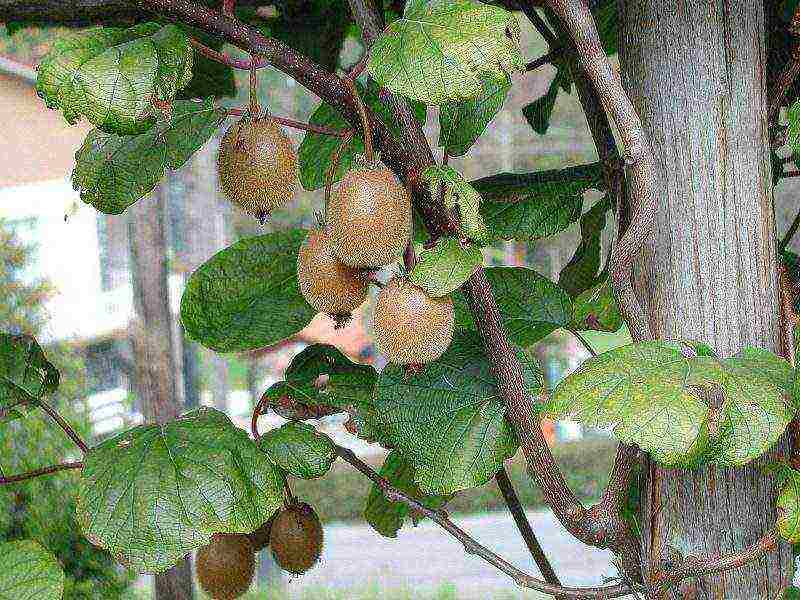
Kiwi loves water very much, so you need to water it regularly, but without fanaticism, so as not to cause rotting of the roots.
You can feed exotics once a year with organic matter. Vermicompost or matured compost is buried in a groove around the trunk. You can't dig deep - the roots of the plant are superficial and it does not like loosening. It is better to mulch the soil in the pot, for example, with chopped wood chips or bark. In summer, during rapid growth, complex mineral fertilizers for indoor plants will not be superfluous. The frequency of feeding is once a decade. As the kiwi grows, more spacious dishes will be needed, where it is transplanted in the spring before bud break.
Why does kiwi die?
The main reason for the death of a plant is the wrong watering regime. It is harmed by both lack and excess of water.
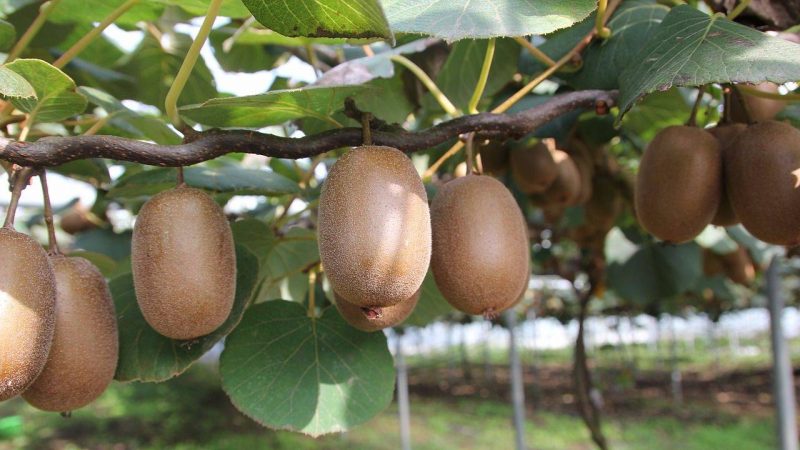
Other reasons include the following:
- the appearance of fungal diseases and untimely fight against them;
- unnoticed pests that do not fight;
- lack of lighting and power;
- freezing of a plant if it grows on a balcony or loggia;
- cutting and pinching shoots during active sap flow;
- damage to young shoots by cats that like the smell of kiwi.
In home culture, kiwi is rarely sick and damaged by pests. Subject to all the rules of agricultural technology, the plant will be healthy, it will give you tasty and very healthy fruits.
Even inexperienced growers can plant this overseas fruit at home. The whole process can be divided into three stages, which do not require special skills or special knowledge.
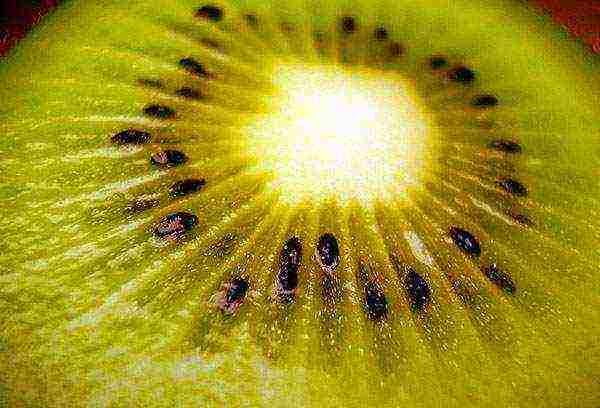
Step one - preparing the seeds
Seed preparation for planting is as follows. The seeds must be removed with a spoon, then placed in a fine sieve (gauze can be used) and rinsed under running warm water, carefully separating them from the fruit pulp.
Important!
Fragments of pulp should not remain on the seeds, the further health of the seedlings depends on this.
The number of seeds should be determined on the basis that many of them may not germinate. It is best to start germination with 20-30 pieces, leaving the strongest ones as they grow. Growing kiwi from seeds at home does not require much time or money. The main thing to remember is that this plant is a rainforest inhabitant. He needs warmth, good lighting and regular moisture (both the soil and its aboveground part).
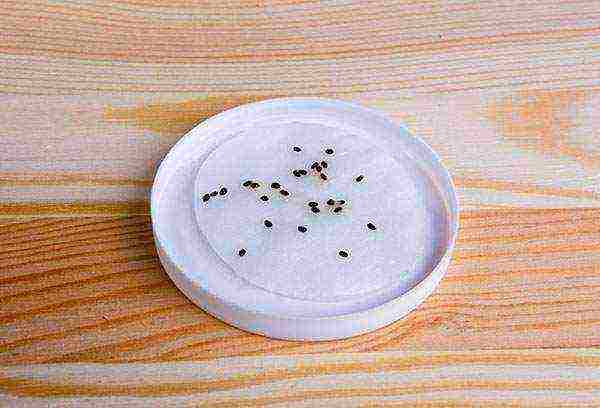
Step two - planting seeds
There are three ways you can start germinating your seeds.
- Peeled and washed kiwi seeds are placed in a tank with settled (or boiled) water at room temperature. A vessel with planting material is placed in a warm room, it is possible near heating appliances. The most "live" seeds will hatch by the end of the first week, but if germination is delayed, you should replace the water with fresh water and wait a few more days.
- The second method is similar to the first, but differs in that the kiwi seeds are placed in a napkin or cotton wool soaked in warm water. The water should completely soak the cotton wool, but it should not fill the entire area of the plate. Next, a plate with seeds is tightly covered with cling film and placed on a warm windowsill. At night, it is better to remove the film, allowing the seeds to breathe. In a week, the most active of them will be revealed.
- The third method is fundamentally different from the previous ones. It consists in sowing kiwi seeds directly into peat without presoaking. The peat should be well and evenly moistened, the seeds are sown to a depth of no more than 5 mm. For early germination, it is necessary to create a kind of greenhouse at home. The container with seeds is covered with cling film and placed in a place with an air temperature of at least + 25 ° C. Watering should be done regularly, the soil should not dry out.
Advice
It is better to moisten the soil with a spray gun, so as not to erode the soil and not wash the seeds on its surface.

The third step is planting germinated seeds in the ground
When the soaked seeds opened and small roots appeared, it's time to continue growing kiwi in specially prepared soil. The soil can be mixed at home on your own, or you can buy ready-made soil mixture for vines. The main thing is that it should be well aerated, with a high content of coconut fibers and vermiculite. Seeds are placed in prepared pots in several pieces. In the future, only one, the strongest sprout is left, the rest are removed at an early stage (in the presence of two or three leaves).
Important!
The plant needs to provide a full-fledged drainage system, since the health of the root system depends on it.
A thick layer of expanded clay is poured onto the bottom of the pot, which will become a permanent "home" for a still young plant, which will prevent excess moisture from stagnating at the roots, and will also provide soil respiration. As a material for drainage, not only expanded clay is suitable, but also calcined pebbles, broken tiles, pieces of foam.
The pot with future seedlings is covered with glass, transparent plastic or film. The best place for such an impromptu greenhouse is the southern window sill in a warm room. Growing kiwi at home requires compliance with a certain temperature regime. Before the first sprouts appear, the air temperature should be at least 25 degrees Celsius, bottom heating of the pot is allowed.
The greenhouse is aired daily. The soil is regularly moistened with warm, settled water using a spray bottle. In no case should it be allowed to dry completely. When the sprouts reach 1–1.5 cm, the greenhouse is completely opened.
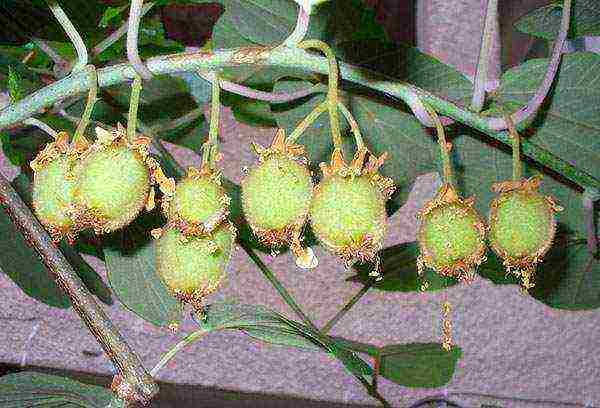
Home care for kiwi
It should be borne in mind that kiwi is a fast-growing liana, which needs strong support for growth. In nature, the plant uses nearby trees for these purposes. In indoor conditions, these should be well-fixed nets, artificial trunks and other suitable supports available in the house.
According to the principle of growth, kiwi resembles grapes. Under natural conditions, its length can reach 8 meters, in culture - about 3. Starting from tiny seeds, it is difficult to imagine that in the coming years an exotic liana will bear fruit at home.
Important!
Kiwi is a fast growing plant that actively consumes nitrogen. Every spring (at the beginning of the growing season), it is imperative to feed the plant, replenishing the lack of essential minerals in the soil. First of all, it is worth remembering the saturation of the substrate with nitrogen. In no case should such events be carried out in the autumn-winter period.
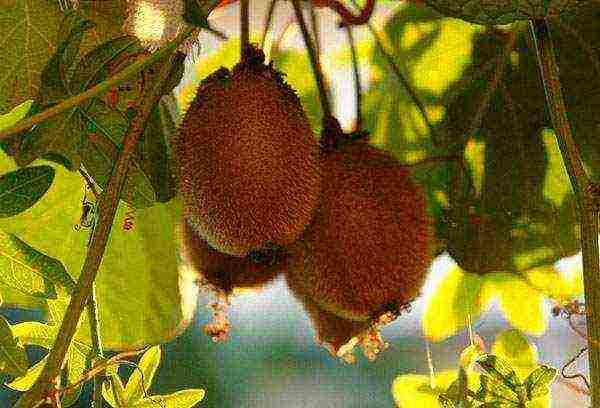
Watering and lighting
Since the kiwi is a native of tropical rainforests, it is necessary to create the appropriate conditions for it to feel "at home." First of all, this applies to high humidity.It can be created using special air humidifiers, as well as by regularly spraying the plant (which is extremely important). A good result is given by placing the pot in a pallet with expanded clay and water.
Drying out the soil is very dangerous and can destroy the plant. With a lack of moisture, the leaves droop, and if measures are not taken in time, they begin to dry at the edges and subsequently fall off. Water the plant so that the water completely moistens the soil and goes out through the drainage holes into the pan.
Lighting for a plant, both in nature and at home, needs bright, which is an indispensable condition for the full growth and fruiting of vines. In this case, direct sunlight can leave burns on the leaves.
Advice
In summer, at home, you should create the effect of diffused sunlight during the hottest hours of the day. Tulle works well for this.
The lack of light has an extremely negative effect on kiwi - the plant stretches out, the leaves become smaller and brighter, the flowers do not develop, and fruiting does not come.
Planting kiwi at home is not difficult at all, and growing it is not a hassle. All that needs to be done is watering, fertilizing and pruning in a timely manner (this process is practically no different from pruning grapes). The plant, in turn, will certainly thank you with its vitamin fruits!
